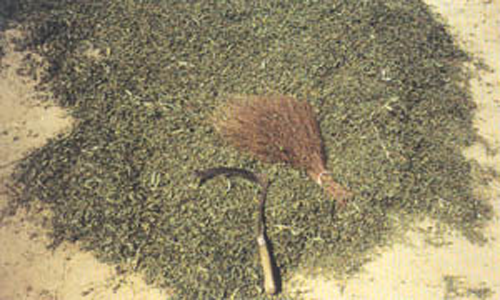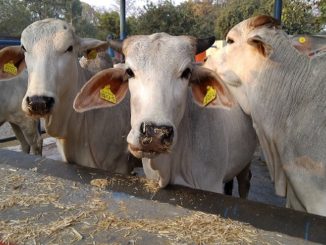India is an agrarian country, agriculture has 4% share in GDP of India out of that about 29% have contributed by livestock sector. The rural, as well as urban people, are directly linked with agriculture and livestock. They produce cash crops and fodder for their own livestock and also for commercial purposes. Cropping system mainly depends on landholding of the farmers. Most of the farmers have less than two acres landholdings so they have an only limited area to grow different crops for food and livestock feeding purposes. Most of the farmers have their livestock either for their own need of milk and meat purposes. As naturally occurring pasture are not suitable for grazing of the livestock animals, mostly buffaloes rely on cultivated forages.
Large numbers of dairy stock are kept in and around the cities and fodder has to be brought in from village areas. Low milk yield, less reproductive efficiency, delayed maturity and poor animal growth rate are major constraints due to imbalanced nutrition. The provision of balanced nutrition and proper feeding management can boost up the animal productivity by more than 50 percent with the existing gene pool. In consideration of this scenario, it is of utmost importance to conserve the available green fodder to ensure regular supply for feeding especially during lean period (Drought or heavy rainfall or scarcity) and in urban areas. This can also be used in the current lockdown period due to COVID 19 pandemic. Green fodder can be preserved either by conversion into silage or through drying up as of hay. Conserving green fodder in the form of silage is one of the best options to ensure regular supply throughout different seasons.
Here we have explained the method of silage and hay preparation in brief.
Silage
It is an anaerobically fermented conserved green fodder having moisture content 65-70%. Fermentation under anaerobic conditions preserves the nutritive value and enhances the keeping quality of the fodder. The process of conserving green fodder in this way is termed as ensiling. For ensiling, fodder crops rich in soluble carbohydrate are incubated for 45-50 days under anaerobic conditions. This is highly palatable and also enhances the performance of dairy animals.

Crops suitable for silage
Generally, the fodder crops rich in soluble carbohydrates and low to medium in protein content are ideally suitable for silage-making. A high content of soluble carbohydrates provides an excellent growth medium for the anaerobic bacteria to form abundant acids which increase the keeping quality of the silage. Thus, maize, jowar, bajra, guinea grass, para grass and Napier grass are highly suitable for making good quality silage. On the other hand, leguminous fodders, which normally have high moisture and high crude protein and low soluble carbohydrates at the comparable growth stage, are not considered fit for silage making.
Steps of silage preparation
- The fodder crops should be harvested and chaffed at the proper stage of growth (flowering stage) so that the moisture, protein and carbohydrate contents are optimum for anaerobic fermentation. The green fodder should have about 30-35 per cent dry matter. This is achieved by wilting the crops for certain periods before filling the silo pits, if they have excess moisture, or by sprinkling a small quantity of water on each layer of the chaffed material, if it has less moisture.
- In the case of katcha silo pits, their bottom and sides should be carpeted with dry grasses so as to make a 5-6-cm thick carpet all around. This carpeting helps to prevent the direct contact between the freshly chaffed material and the soil.
- The fodder to be ensiled should be chaffed into small pieces, preferably 1-2 cm long.
- The silo pits must be filled very quickly and the material must be compacted in such a way as to remove as much air as possible through constant pressing either by manual labour or with bullocks or tractor or with combination of all three. The exclusion of air causes efficient fermentation under anaerobic conditions.
- The height of the chaffed material should be about 1-2 metres above the ground level. During the course of fermentation, the material gradually settles down.
- Urea and molasses at the rate of 0.5% and 5 %, respectively of the chaffed material is mixed with, or sprinkled thinly and evenly on different layers, if the chaffed material happens to be very low in protein content, especially in the case of cereal fodders and sugarcane tops.
- After filling and compacting the material carefully, the silo pits should preferably be given a dome-like shape. Such shape facilitates the drainage of rain-water, which otherwise would enter the ensiled material, and deteriorate the quality.
- The ensiled material is then covered with a polythene sheet or a tarpaulin from all sides so as to protect it from the direct rays of the sun and from rains.
- After a week, the polythene sheet is removed and the material is compacted again so as to consolidate the chaffed material and remove the air to the greatest possible extent. The polythene sheet is then placed back. However, if the polythene sheet is not available, a thick layer of straw is put on the chaffed material from all sides, and over the straw, a thick layer of moist soil (10-12 cm) is spread. The surface is covered in a mud plaster prepared by adding dung and water to the earth, in suitable quantities. This avoids the contact of atmospheric nitrogen with the ensiled material, since the atmospheric nitrogen prevents fermentation under anaerobic condition.
- The chaffed material ensiled by the above procedure is ready for feeding to the livestock after 2-3 months. A silo pit is opened and the material is removed daily for feeding by exposing as little as surface of the ensiled material as possible. This is done mainly to prevent the direct contact of the feeding material with sunlight and to prevent air-drying.
Silage may be fed in small quantities (4-5 kg per cow) to start with, and later the quantity may be increased to 15-20 kg so that the animal is able to adjust itself to the new feed. During an acute fodder scarcity when nothing is available for feeding, it has been reported that silage is able to meet the full requirements of the animal in respect of dry matter and essential nutrients.
Quality of silage
The quality of silage is appreciated from its colour and odour. Good silage should be golden (greenish or yellowish brown) colour, with pleasant odour, and possess a high acid content. On the other hand, if the silage has butyric acid, it is yellow and emits offensive odour or has become dark brown and gives out tobacco-like odour owing to heating, it is poor silage, though it may be palatable to the livestock, but feeding value is very low.
- Very good silage: It is having acidic taste and odour, free from butyric acid, moulds, sliminess, showing a pH range of 3.4- 4.2 and with ammoniacal nitrogen less than 10% of the total nitrogen.
- Good silage: Silage possessing acidic taste and odour, traces of butyric acid, pH 4.2-4.5 and ammoniacal nitrogen 10-15% of the total nitrogen
- Fair silage: Ensiled material with some butyric acid, a slight proteolysis, some moulds, pH 4.8 and above and ammoniacal nitrogen 20% of the total nitrogen.
- Poor silage: It is having bad smell due to high butyric acid and high proteolyses, may be infested with moulds. The pH is between 4.5-4.8. Ammoniacal nitrogen is more than 20% of the total nitrogen.
Hay
Hay refers to grasses or legumes that are harvested, dried and stored at 85-90% dry matter. It can be safely stored for long periods. The quality of hay largely depends on the species, the stage of harvesting and freedom from moulds and bacteria. Good quality hay must retain a larger proportion of leaves which become brittle on drying and fall off quickly. In addition, the cured hay should have a natural green colour, pleasant aroma, optimum moisture content, freedom from moulds, etc. During hay-making, particularly in the hot summer, excessive and direct exposure to sunlight should be avoided, since it causes bleaching.
Crops suitable for hay
The efficiency and quality of hay-making are determined by the moisture content in the fodder species and the ease with which moisture can be removed. Thus all the thin-stemmed grasses namely anjan, sain, moshi, dhaulu, spear, blue panic, sewan, marvel, dinanath, oat, Rhodes grass, thin guinea, thin Napier; and legumes, viz. lucerne, berseem, senji, peas, methi, vetches, cowpea, field bean, rice bean and velvet bean, can be conveniently and quickly dried, unlike thick-stemmed fodders, which take more time for drying. However, if the thick-stemmed fodders are required to be dried quickly, they should necessarily be chopped into small pieces or crushed by passing the material in between rollers
Stage of harvest
The quality of the hay is directly related to the stage of harvest of the fodder species, leaf-stem ratio and the moisture content. Thus, the fodder crops namely cowpea, velvet bean, guar, moth, jowar, bajra, Sudan grass, teosinte, and oats, should be cut at the flowering stage for hay-making. Pasture and the cultivated grasses are cut at 50% blossoming or slightly earlier to prevent the lignification of the cellulose, losses of protein, energy and palatability, which are caused due to the advancement of plant growth. Lucerne and berseem are cut for hay-making at 30-40 days intervals. The fodder crops should not be harvested immediately after irrigation. They should rather be harvested in the afternoon and before applying irrigation, so that they have less moisture and more of dry matter. They will also take less time to dry.
Steps for hay making
Though the fodder species can be dried as such, the best-quality hay is made by chaffing the species into small pieces with a hand-driven chaffing machine or with a power-driven chaff-cutter. The chaffed material is spread evenly in thin layers and is turned two or three times daily. In the evening, the half-dried material is raked and collected in the form of a cone so as to prevent from moistening due to dew at night. On the second day, the material is again spread evenly after the dew just disappears. The material is turned frequently, depending upon the climatic conditions, namely, the degree of sunshine, the wind velocity, and humidity. In the case of lucerne, berseem and cowpea, the leaves are very brittle and fall down quickly. During summer, the hay of lucerne, cowpea, etc. may preferably be made in shade so that the bleaching action may be reduced to the minimum.

Finally, the hay which contains 15% moisture is transported to the hay-barn. It should retain the green colour, good aroma and flavour. It should preferably be stored at a low temperature and humidity so as to prevent losses owing to the oxidation of the carbohydrates. The losses may be as high as 40-50 per cent if not stored properly. In order to minimize the space for storage and for effective long-term storage, the hay is turned into bales of suitable sizes with manually-operated or power-driven hay-balers.
Conclusion
Lack of adequate and high-quality feed is a major constraint to dairy production in India, particularly in dry periods and movement of crisis like lockdown due any pandemic. Forages play varying roles in the different livestock production systems. Livestock can be sustained on conserved forage and fodder from the high yields produced during the rainy season, when there is often an excess. Conservation either through silage or hay technology would be appropriate for the smallholder dairy farmers having less than 10 animals.







2 Trackbacks / Pingbacks